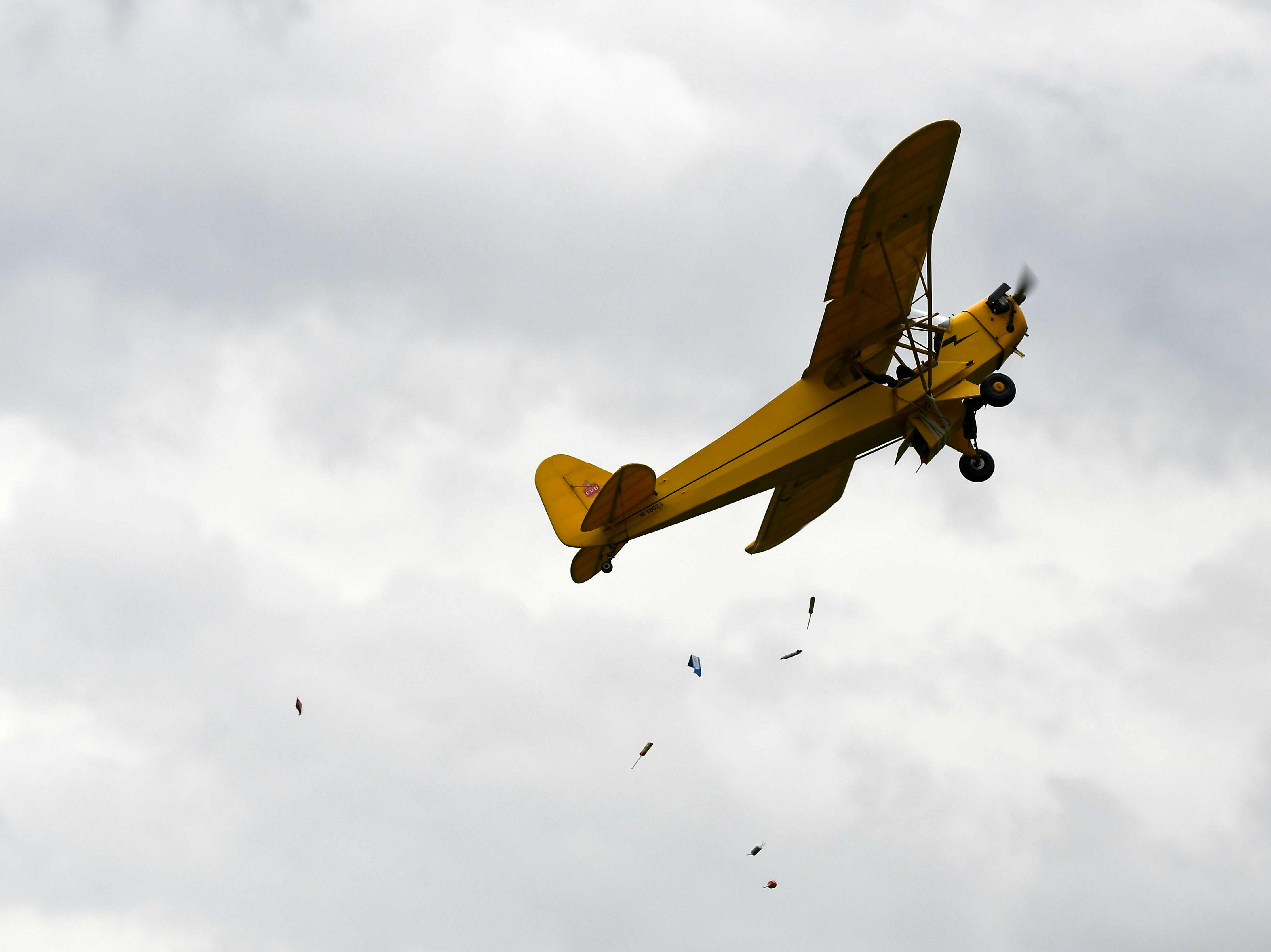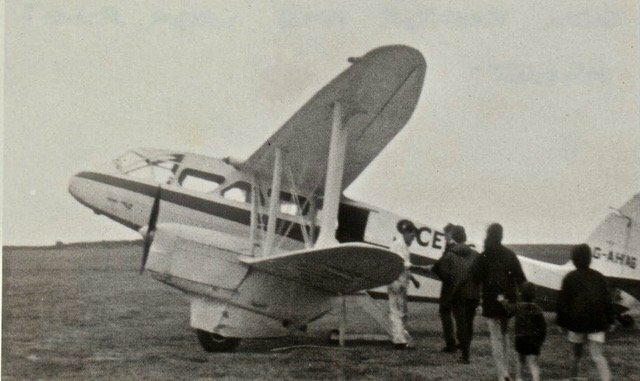-
Posts
12,610 -
Joined
-
Days Won
21
Content Type
Profiles
Forums
Blogs
Gallery
Calendar
Downloads
Posts posted by Martin Harris - Moderator
-
-
That would have been Tom Wright.
The easiest solution is to use the same propeller and cell count in your new model. If the combination isn’t suitable, you could measure the power (watts) with a wattmeter and use that as the top limit for a different cell count/propeller combination - checking that the current (amps) doesn’t exceed the ESC rating.
-
Almost inevitably - I’m unavailable for flying this weekend!
-
Funnily enough I just tried this too and noticed that counterintuitively, the contrast increases as you turn the roller to the left.
-
A heavier prop will be of benefit in manoeuvres involving torque and gyroscopic effects such as the Lomcevak.
-
Similarly, these are what we use - with the LED on extended leads. Very handy as one type can be used for a variety of functions.
https://store.flytron.com/collections/led-light-systems/products/strobon-v2-navigation-light
The lenses which they sell complement the effect on the nose light but my top mounted one works well without.
https://www.flytron.com/products/strobon-v2-polycarbonate-lens
-
 1
1
-
-
Isn’t the trade name Whattmeter rather than wattmeter?
Strictly speaking, they don’t measure watts but calculate them from the product of measured voltage and current.
-
The wing “trick” is the most reliable.
I have a white LED fitted in the nose of my Arrows Hawk (and a strobing one on the top decking) which have their uses when flying in a tight gaggle of 5 or more as we frequently enjoy, but their primary benefit is cosmetic.
The downside is while doing an approach in poor light when you can lose the wings in the glare - fit a switch so that you can turn it off!
-
 1
1
-
-
Several speculative posts (and replies quoting them) removed. Please respect Jon’s request not to post comments and questions about the decision made by the company’s owner.
From a personal point of view, I’m saddened by the loss of these fine engines in the near future and wish Jon (and his fellow employees) all the best for the future and thanks for all his efforts over the years. Thanks also to Neil Tidey for the original design and concept of the Laser engine family.
-
 5
5
-
-
Great that it’s sorted - hope you enjoy flying it.
-
You can open the throttle after turning the transmitter on - it’s the ESC seeing full throttle when the flight battery is connected that starts the training sequence.
-
 2
2
-
-
The theory is that the engine runs at peak efficiency to charge the battery which acts as a reservoir for driving the electric motor(s). Unlike a conventional engine which has to run at varying speeds and loads with complex sensor monitored controls.
It’s an interesting concept that seems to have value while the electric charge infrastructure is being developed or a better alternative is found. It does nothing to reduce reliance on fossil fuels. While there are batteries to carry, I would imagine there are weight savings on a larger engine and transmission to help balance the differences.
-
 2
2
-
-
30 minutes ago, Fly Boy 3 said:
Will do Martin, but I do get full control when using servo tester system.
That’s exactly the point. Your ESC and motor have been shown to be working so it has to be a problem with the signal being seen by the receiver. Did you confirm that the other servos e.g. ailerons, elevator, respond to control inputs to confirm that your receiver is bound to the transmitter? If so, then follow Rotten Row’s guidance.
-
Have you performed the ESC training procedure? If your transmitter’s throttle range isn’t recognised then the ESC may not operate the motor. Before doing anything, check that the throttle range hasn’t been altered from default and that the trim is at neutral.
-
Reconnected the ESC? I assume you mean reconnected it to the receiver.
No - if your motor runs correctly then it may be a transmitter programming problem. Do you have the ESC plugged in to the correct throttle channel in the receiver? It may not be channel 3 as you're used to with Futaba - I don't know FlySky. Do the other controls respond? If not, there could be a binding error.
-
6 hours ago, SIMON CRAGG said:
Whatt meter = my bad!
What? What's a whatt? What's bad in your earlier post? The unit being measured is the watt (note the lack of capitalisation) abbreviated to W (note the capitalisation).
Unless you're referring to a trade name, I think you could argue that wattmeter without the space would be the correct spelling for the power measuring equivalent of the voltage measuring voltmeter. An ammeter rather messes up the pattern...
-
While a servo tester will give a "clean" input to the ESC, you still need your ESC to control the motor so it will be at the same risk of damage from a faulty motor.
P.S. I'm assuming this is a 3 phase brushless motor and not a DC one?
-
On 31/01/2024 at 22:51, Rapide said:
And there's a happy ending:- I said that I was building the Rapide because it was the first aircraft I ever flew in - with my sister and dad from Bembridge to Hilsea (Portsmouth). My sister unearthed a photo of us boarding, which she confirmed was 1956 and the Registration number is clearly visible. When I googled the number, to my utter surprise, I found it is still flying 😊. I have been in touch with the current operator, Scillonia Airways, and will relive the flight this year.
Damn - that means I've got to change the colour scheme.............
I'm a bit confused...it happens...too often these days...
Your sister seems to have kept a photo of you boarding G_AHAG - you only flew in 1956 - a current pilot, who I'm assuming wasn't associated with the aircraft in 1956, told you it wasn't labelled as SCENIC at that time? Did you get any further with your research?
-
While it could be a myriad of things, the first that comes to mind is whether you're using a Futaba transmitter? Why should that make a difference? Futaba throttles work the opposite way to almost everyone else's and need reversing, otherwise most ESCs won't arm. Also, have you calibrated your ESC - usually a case of connecting the battery with the throttle wide open (propeller NOT fitted please!) wait for the beeping to stop and close the throttle - refer to specific instructions if possible. Don't forget that if you're reusing an IC model memory, the end points must be returned to 100% range.
-
 1
1
-
-
I've pasted this exceptionally clear explanation (I can understand it!) of the technical differences from another thread - thanks Pete:
On 09/06/2013 at 17:31, Peter Christy said:Any superhet receiver will respond to two frequencies, equally spaced either side of the receiver crystal frequency. A single conversion receiver normally uses a 455 KHz intermediate frequency, so it will respond not only to its own transmitter, but equally one 910 KHz (2*455) on the other side of the receiver crystal frequency. For example, a receiver on 35.070 MHz will actually use a crystal of 34.615 MHz. The difference between the two frequencies is 455 KHz, and it is this frequency that is amplified and detected in the receiver. However, it will also respond to a transmitter on 34.160MHz, which is also 455 KHz away from the receiver crystal frequency. The unwanted transmitter should be filtered out by the front-end tuning coils in the receiver, which are tuned to 35 MHz, not 34 MHz. However, the level of selectivity is slight at these frequencies, and the receiver response is probably only about 3dB down.
This usually isn'y a problem as there are no model control systems on the 34 MHz band - I think its used by the military.
However, by increasing the IF frequency to 10.7 MHz, the "image" frequency is now 21.4 MHz away from the wanted one rather than just under 1MHz, and can easily be filtered out. However, selectivity (10 KHz channel spacing) is difficult to achieve at 10.7 MHz, so a second mixer and IF is added to step it down again to 455 KHz again. (Hence "double-conversion")😉
So, a single conversion receiver will have an image frequency 910 KHz away, and a double conversion will be 21.4 MHz away. A double conversion receiver will be almost totally immune to interference on the image frequency, at the cost of extra complication in the receiver.
The receiver crystal for a single conversion receiver will normally be 455 KHz less that the Tx crystal (34.615 MHz in our example). A double conversion will be 10.7 MHz below, or 24.37 MHz for a transmitter on 35.070MHz. Clearly, one will not work in the other!
(Some receivers use "high-side injection", where the local oscillator is above the transmitted frequency, moving the image frequency above the wanted transmitter frequency, but I have ignored this for clarity! The principle is still the same.....)
Pete
-
 3
3
-
-
1 hour ago, GrumpyGnome said:
Presumably, if the forum is down/broken, that web page will be too........... an email address would be separate.
Not necessarily but FB3 was asking about log in issues relating to his forum account.
You could access the contact page and make a note of the contact addresses if you want additional security GG.
-
Hi - there’s not really any likelihood of you having these problems again but there are contact details on https://www.modelflying.co.uk/contact-us/
that should enable a message to reach the forum owners. You don’t need to be logged in to access this facility
-
Unlikely if it’s an OS.
-
It’s not clear whether this was a club or a commercial drone concern but of course the reporting system is anonymous. However, there are clues in the report which would certainly narrow down the location as it seems to be located at around 700 feet altitude.
-
It would certainly be sad if such attitudes and obvious misunderstanding of the NOTAM system jeopardises the hard work behind the privileges granted to the BMFA.
-
 2
2
-




Winter is here....who's been flying?
in Flying Field Reports and Chat
Posted
Is it time to put winter to bed and reopen the spring thread?